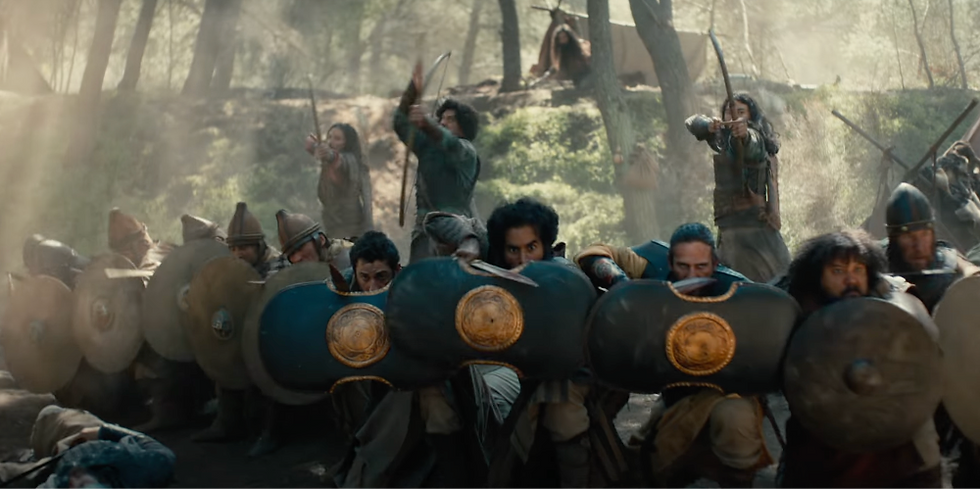The Course of Empire (Adapting Genesis 10-11)
- Kevin Keating

- Dec 2, 2019
- 5 min read
Film adaptations need to follow a primary character. Unlike the narratives of Scripture, the Bible Artist can't get away with claiming a "crowd" or "the Babylonians" took an action. When the adaptation visualizes the action, it will assign responsibility to specific individuals. That's why I spent time a couple weeks ago thinking about what kinds of characters might serve as protagonists and antagonists in an adaptation of the Tower of Babyl story.
...the Babyl story is not about how a mob-mentality led to a momentary breakdown in an otherwise healthy society
Yet I stand by the point I made in my original post on this section: the original Babyl story appears to obscure the individuality of its characters for a reason. The Babyl story is not about a corrupt king who destroys an innocent people. It's a story about a foolish people who collude together in bringing about their own destruction. That's why every human action in the story is performed by a group and every line of dialogue is spoken in the first person plural:
And they said to one another, “Come, let us make bricks, and burn them thoroughly.” And they had brick for stone, and bitumen for mortar. Then they said, “Come, let us build ourselves a city and a tower with its top in the heavens, and let us make a name for ourselves, lest we be dispersed over the face of the whole earth.” (Genesis 11:3-4, ESV)
But the Babyl story is not about how a mob-mentality led to a momentary breakdown in an otherwise healthy society. Sandwiched as it is between extensive genealogies describing the connection between various people-groups and kingdoms, the context of the story clearly suggests that the events described have their roots in history. Moreover, the way that this story seems to recapitulate or at least connect to elements of the Cain Story suggests that we are meant to see it as part of a bigger narrative and not merely about a specific situation. Babyl is merely the flowering of a cultural impulse that has been building steam since time immemorial.
![The Savage State from The Course of Empire by Thomas Cole [Public Domain]](https://static.wixstatic.com/media/f9cc30_c007e33072d9494aa95220045cfb9962~mv2_d_8880_5520_s_4_2.jpg/v1/fill/w_980,h_609,al_c,q_85,usm_0.66_1.00_0.01,enc_avif,quality_auto/f9cc30_c007e33072d9494aa95220045cfb9962~mv2_d_8880_5520_s_4_2.jpg)
If you want to see an example of how this sort of culture-wide, historically-rooted narrative can be embodied in a static visual art form, you need go no further than Thomas Cole's "The Course of Empire" series. The grand scale of each painting negates any sense of personal agency on the part of the individuals depicted within. We can recognize that the subject is not one, two, or even twelve people; it's an entire culture. Moreover, when displayed together, the subtle connections between each work makes it clear that the individual paintings aren't about isolated moments in time; they're about a historical trajectory. This is the kind of narrative that an adaptation of the Babyl story needs to tell, while working within the unique constraints of its medium.
![The Arcadian or Pastoral State by Thomas Cole [Public Domain]](https://static.wixstatic.com/media/f9cc30_8b1c51c9a92449d292ab3f84f81d386e~mv2_d_8733_5442_s_4_2.jpg/v1/fill/w_980,h_611,al_c,q_85,usm_0.66_1.00_0.01,enc_avif,quality_auto/f9cc30_8b1c51c9a92449d292ab3f84f81d386e~mv2_d_8733_5442_s_4_2.jpg)
Making Babyl a Culture-Wide Story
Having gone to the trouble of introducing a protagonist for audiences to follow, we now need to consider how to avoid giving individual players too much agency in building the tower. Here are a couple approaches:
1) Man vs. Society Story
Instead of focusing on the events that led to the building of the tower of Babyl, an adaptation could take place at a point when the building is already underway and taken as a given by society. We don't need to be told who started the building project, and we may not even get to see who's ultimately in charge of it. Instead, a majority of the characters we come across can exhibit a shared commitment to the tower-building ideology. The main character (and any allies he/she might have) is depicted as either an outsider (e.g. the slave protagonist) or a non-conformist/revolutionary (e.g. the prophet), which leaves the audience to assume that most people in the society agree with the building project
2) Emblematic Representation
If an adaptation focuses on the origin of the building project itself, inevitably we'll see individual characters who initiate construction. That doesn't mean, however, that the film has to highlight the agency of those specific individuals. Even in non-democratic societies, individuals often serve as representatives who (at least in theory) carry out the will of the whole. In film, audiences can easily recognize when a chieftain-like character is emblematic of an entire slice of society. This technique is often used in historical epics like Braveheart, which face a similar challenge.
Applied to the Babyl story, Emblematic Representation would involve having a group of chiefs or elders who arrive at the decision to build together. If cued correctly, we will not view the decision of these men as the mistake of a few individuals but rather the collective folly of all layers of society, as they are embodied in a handful of relatable representatives.
Making Babyl a Historically-Rooted Story
As long as the filmmaker is careful to avoid suggesting that building-project is revolutionary or a result of innovation or a recent situation, I think the techniques suggested above to convey culture-wide investment should also hint at historical roots. However, if the adaptation wants to really drive home that point, here are a couple ideas:
1) Historical Prologue
Before launching into the main narrative, we could view a very short prologue that takes place at the same location but in a more primitive setting (e.g the time of Cain or Ham). We see a short scene that depicts what similar impulses looked like at that less-advanced society (e.g. something involving enslavement, self-protective violence, and/or idolatry). We're then left to recognize the construction project as merely a more polished version of the same nasty tendencies.
![Destruction from "The Course of Empire" by Thomas Cole [Public Domain]](https://static.wixstatic.com/media/f9cc30_aabeff420e974953bb11b9667c698af4~mv2_d_8917_5532_s_4_2.jpg/v1/fill/w_980,h_608,al_c,q_85,usm_0.66_1.00_0.01,enc_avif,quality_auto/f9cc30_aabeff420e974953bb11b9667c698af4~mv2_d_8917_5532_s_4_2.jpg)
2) Invocation of Ancestral Hopes or Prophecies
Within the scope of the story, an elder of the Babylonians could make it known to Nimrod or other characters that their ancestors longed to see this sort of thing happen - or perhaps that prophecies about this sort of thing have been around for some time. Essentially, we are directly told that this is an event that the people has looked forward to or even been preparing for for some time.
3) En Medias Res
The original Babyl story is relatively sparse with narrative details like time-scale, so we don't have any clue how far the Babylonians got before God showed up and scattered them. Given how long ancient building projects could take, an adaptation could begin a generation or more after construction began. This would make it clear construction wasn't a momentary whim but rather a prolonged, multi-generational folly.
4) Epilogue
This is the historical prologue idea but inverted. Instead of creating a prehistoric prologue scene that foreshadows the main narrative, we could discover that the main narrative is itself merely a foreshadowing of the future Babylonian Empire that the Israelite would come into conflict with. Like the prologue, this effect could be brought about by setting the epilogue depiction of the Neo-Babylonian Empire in a similar location and including similar impulses (or even the (re)construction of the tower. Although not directly tying the construction to the past, an epilogue would suggest that the impulse to build is not momentary one but rather deeply embedded in the societal psyche. Moreover, the prologue and epilogue could be combined to suggest together a kind of recurring cycle.
![Desolation from "The Course of Empire" by Thomas Cole [Public Domain]](https://static.wixstatic.com/media/f9cc30_01c9b65ac01c4e34a71526947342067b~mv2_d_8881_5526_s_4_2.jpg/v1/fill/w_980,h_610,al_c,q_85,usm_0.66_1.00_0.01,enc_avif,quality_auto/f9cc30_01c9b65ac01c4e34a71526947342067b~mv2_d_8881_5526_s_4_2.jpg)
Any other suggestions on your part? Tweet them to me @TheBibleArtist #ReadLikeAnArtist.














Comments